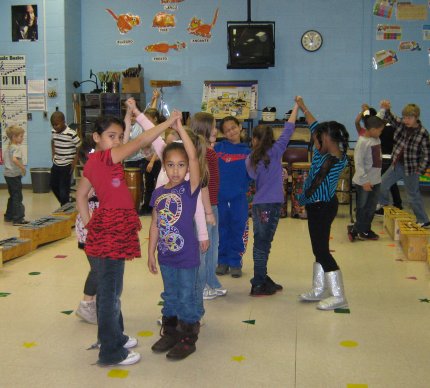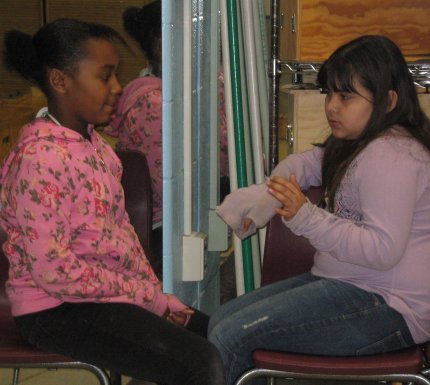If you have been in education for any amount of time, you have been exposed to many different strategies to improve the teaching process. I am excited to share another option to add to your toolbox of teaching essentials, cooperative learning with music - Kagan style.

Students at Williams Science & Fine Arts Elementary using Rally Robin, Stand Up, Hand Up, Pair Up.
Flash forward to 2011. As the district is completing our final training in Kagan, whispers of a Kagan music book emerges. Two music teachers who had also found Kagan as another exciting option for teaching cooperative learning had put all their activities into a book. Our district music coordinator arranged for the two authors, Marya Katz and Christi Brown, to come and present their book to our music staff. This in-service was a most informative, useful and enjoyable day. The authors were energetic and knowledgeable. Even more exciting, every structure could be used at any level: Primary, Secondary, General Music, Vocal, and Instrumental. Wow. What a rare happening to have a group of structures that were already modified at any level and we had the authors in our midst to pick their brains and gain knowledge. Plus, we had all the resources complied in one book. Life was good. We started with the teambuilding and class building activities. Before engaging in these activities, we had to find a partner. During the day we had four different partners. We danced to meet our telephone partner when we heard "Yackety Yak," met our spy partner when we heard the theme from "Mission Impossible," and met our dance partner when we heard "Land of a Thousand Dances." It was so enjoyable. We got to dance, have fun with music, and learn about each other. As we continued with each activity, I thought about how much fun the activities would be to use with my students. We also used some common Kagan structures but with a music focus, such as Timed Pair Share, Rally Robin, and Rally Coach. (See Chart 1)

The authors gave step by step instructions for instrumental (band, strings, Orff), vocal (choir, singing), and general music (K-5 theory). I could actually see myself implementing cooperative learning at any level, in any facet of music instruction. What an excellent resource for veteran, newer, and future music teachers.
After the in-service my job was to implement those activities with my students. Remember, I had already used these structures previously, but now I had ready- made resources and activities that had already been kid-tested in the music classroom. I had the same feeling you get that first day of school, excitement and nervousness all in one. I chose to use a teacher driven activity-timed pair share and a student driven activity-rally coach focusing on Orff instruments and mallet technique. The students loved it and it was exciting to see smiles on their faces as they were actively engaged and building knowledge. All students had a moment to share their thoughts and be heard. Every student had the opportunity to be successful or get extra help if they needed it.
As educators we are always growing in our craft by learning new techniques or refining old ones. I urge you to consider looking at Kagan cooperative learning as another resource to add to your box of essentials music teaching tools.
Recommended resources by Marya Katz and Christi Brown include: Cooperative Learning & Music and Match Mine Music, Kagan Publishing.

Two students at Williams Science & Fine Arts
Elementary using a Kagan music activity.